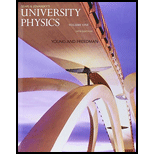
BIO ANESTHETIC GASES. One type of gas mixture used in anesthesiology is a 50%/50% mixture (by volume) of nitrous oxide (N2O) and oxygen (O2). which can be premixed and kept in a cylinder for later use. Because these two gases don’t react chemically at or below 2000 psi, at typical room temperatures they form a homogeneous single gas phase, which can be considered an ideal gas. If the temperature drops below −6°C, however, N2O may begin to condense out of the gas phase. Then any gas removed from the cylinder will initially be nearly pure O2; as the cylinder empties, the proportion of O2 will decrease until the gas coming from the cylinder is nearly pure N2O.
19.63 In a test of the effects of low temperatures on the gas mixture, a cylinder filled at 20.0°C to 2000 psi (gauge pressure) is cooled slowly and the pressure is monitored. What is the expected pressure at −5.00°C if the gas remains a homogeneous mixture? (a) 500 psi; (b) 1500 psi; (c) 1830 psi; (d) 1920 psi.
19.64 In another test, the valve of a 500-L cylinder full of the gas mixture at 2000 psi (gauge pressure) is opened wide so that the gas rushes out of the cylinder very rapidly. Why might some N2O condense during this process? (a) This is an isochoric process in which the pressure decreases, so the temperature also decreases. (b) Because of the rapid expansion, heat is removed from the system, so the internal energy and temperature of the gas decrease. (c) This is an isobaric process, so as the volume increases, the temperature decreases proportionally. (d) With the rapid expansion, the expanding gas does work with no heat input, so the internal energy and temperature of the gas decrease.
19.65 You have a cylinder that contains 500L of the gas mixture pressurized to 2000 psi (gauge pressure). A regulator sets the gas. flow to deliver 8.2 L/min at atmospheric pressure. Assume that this flow is slow enough that the expansion is isothermal and the gases remain mixed. Mow much time will it take to empty the cylinder? (a) 1 h; (b) 33 h; (c) 57 h; (d) 140 h.
19.66 In a hospital, pure oxygen may be delivered at 50 psi (gauge pressure) and then mixed with N2O. What volume of oxygen at 20°C and 50 psi (gauge pressure) should be mixed with 1.7 kg of N2O to get a 50%/50% mixture by volume at 20°C? (a) 0.21 m3; (b) 0.27 m3; (c) 1.9 m3; (d) 100 m3.
Want to see the full answer?
Check out a sample textbook solution
Chapter 19 Solutions
University Physics with Modern Physics, Volume 1 (Chs. 1-20) and Mastering Physics with Pearson eText & ValuePack Access Card (14th Edition)
Additional Science Textbook Solutions
Applications and Investigations in Earth Science (9th Edition)
Chemistry (7th Edition)
Chemistry: An Introduction to General, Organic, and Biological Chemistry (13th Edition)
College Physics: A Strategic Approach (3rd Edition)
Campbell Biology (11th Edition)
Microbiology with Diseases by Body System (5th Edition)
- The velocity of a particle moves along the x-axis and is given by the equation ds/dt = 40 - 3t^2 m/s. Calculate the acceleration at time t=2 s and t=4 s. Calculate also the total displacement at the given interval. Assume at t=0 s=5m.Write the solution using pen and draw the graph if needed.arrow_forwardThe velocity of a particle moves along the x-axis and is given by the equation ds/dt = 40 - 3t^2 m/s. Calculate the acceleration at time t=2 s and t=4 s. Calculate also the total displacement at the given interval. Assume at t=0 s=5m.Write the solution using pen and draw the graph if needed.arrow_forwardThe velocity of a particle moves along the x-axis and is given by the equation ds/dt = 40 - 3t^2 m/s. Calculate the acceleration at time t=2 s and t=4 s. Calculate also the total displacement at the given interval. Assume at t=0 s=5m.Write the solution using pen and draw the graph if needed. NOT AI PLSarrow_forward
- The velocity of a particle moves along the x-axis and is given by the equation ds/dt = 40 - 3t^2 m/s. Calculate the acceleration at time t=2 s and t=4 s. Calculate also the total displacement at the given interval. Assume at t=0 s=5m.Write the solution using pen and draw the graph if needed.arrow_forwardThe velocity of a particle moves along the x-axis and is given by the equation ds/dt = 40 - 3t^2 m/s. Calculate the acceleration at time t=2 s and t=4 s. Calculate also the total displacement at the given interval. Assume at t=0 s=5m.Write the solution using pen and draw the graph if needed.arrow_forwardPlease don't use Chatgpt will upvote and give handwritten solutionarrow_forward
- No chatgpt pls will upvote Already got wrong chatgpt answerarrow_forwardAn electron and a proton are each accelerated through a potential difference of 21.0 million volts. Find the momentum (in MeV/c) and the kinetic energy (in MeV) of each, and compare with the results of using the classical formulas. Momentum (MeV/c) relativistic classical electron proton Kinetic Energy (MeV)arrow_forwardFour capacitors are connected as shown in the figure below. (Let C = 20.0 µF.) (a) Find the equivalent capacitance between points a and b. µF (b) Calculate the charge on each capacitor, taking ΔVab = 14.0 V. 20.0 µF capacitor µC 6.00 µF capacitor µC 3.00 µF capacitor µC capacitor C µCarrow_forward
 Principles of Physics: A Calculus-Based TextPhysicsISBN:9781133104261Author:Raymond A. Serway, John W. JewettPublisher:Cengage Learning
Principles of Physics: A Calculus-Based TextPhysicsISBN:9781133104261Author:Raymond A. Serway, John W. JewettPublisher:Cengage Learning Physics for Scientists and Engineers, Technology ...PhysicsISBN:9781305116399Author:Raymond A. Serway, John W. JewettPublisher:Cengage Learning
Physics for Scientists and Engineers, Technology ...PhysicsISBN:9781305116399Author:Raymond A. Serway, John W. JewettPublisher:Cengage Learning Physics for Scientists and Engineers: Foundations...PhysicsISBN:9781133939146Author:Katz, Debora M.Publisher:Cengage Learning
Physics for Scientists and Engineers: Foundations...PhysicsISBN:9781133939146Author:Katz, Debora M.Publisher:Cengage Learning College PhysicsPhysicsISBN:9781285737027Author:Raymond A. Serway, Chris VuillePublisher:Cengage Learning
College PhysicsPhysicsISBN:9781285737027Author:Raymond A. Serway, Chris VuillePublisher:Cengage Learning College PhysicsPhysicsISBN:9781305952300Author:Raymond A. Serway, Chris VuillePublisher:Cengage Learning
College PhysicsPhysicsISBN:9781305952300Author:Raymond A. Serway, Chris VuillePublisher:Cengage Learning





